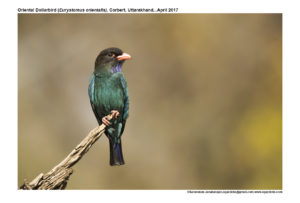
Dollar Bird Eurystomus orientalis
Etymology:
- Eurystomus : Greek word for wide mouth
- Orientalis: Orientalis : From the Orient
Vernacular Names : Lepcha: Tak rel vong, Ta: Pulupporukki, Mal: Kattu panamkakka, Sinh: Kes kavuda, Hindi: Purvi Nilkanth, Lal Chonch Nilkanth, Mar: Kala Nilpankh
Distribution in India: Resident and partial migrant in Himalayas, North East and South West India.
Description: Size of 27-28 cm. It is dark brown but this is heavily washed with a bluish-green sheen on the back and wing coverts. Its belly and under tail coverts are light coloured, and it has glossy bright blue colouring on its throat and under tail. Its flight feathers are a darker blue. Its bill is short and wide and in mature animals is coloured orange-red with a black tip. It has very light blue patches on the outer parts of its wings which are highly visible in flight and for which it is named. The females are slightly duller than the males but overall the two are very similar.
Habitat: It is found in mainly woodland, including canopy and margins of primary lowland rain forest, riparian wood, dense forest
Food Habits: It eats insects and other small invertebrates that they hawk from tall tree perches. They keep returning to the perches once they have caught the prey. Most hunting is done in the early morning and evening twilight. It conspicuously perches on high, bare branches of trees from where they make broad sweeps and glides after prey or dive and swoop in display.
Breeding Habits: They breed during the March- May period. The nest is a shallow, unlined cavity in a tall tree. The clutch is 3-5 eggs. The eggs are laid on wood dust at the bottom of the cavity. Incubation is done by both parents for 17 to 19 days. Young chicks are fed by both parents .The young fledge and leave the nest after about a month.